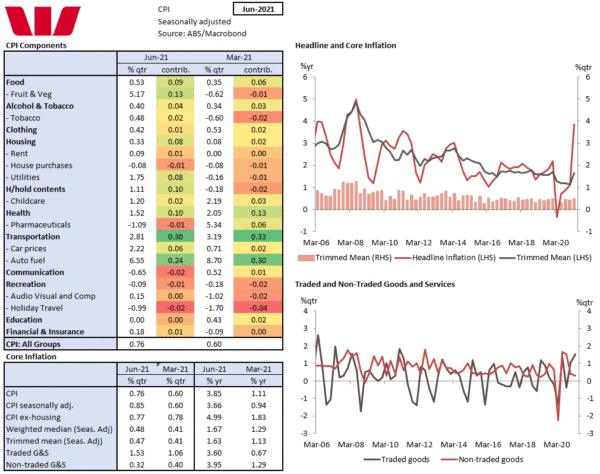Headline CPI 0.8%qtr/3.8%yr; Trimmed mean 0.45%qtr/1.6%yr; Weighted median 0.42%qtr/1.6%yr.
Inflation came in a bit stronger than expected, 0.8% vs. market median of 0.7% (WBC forecast 0.9%) which given this is a recover from the shock of the lockdowns from last year is quite a modest update. At two decimal places it was 0.76% so just sneaks in as 0.8% rounded.
The annual pace lifted from 1.1% to 3.8%, the fastest pace in 12 years but as noted this was due to based effects of the negative prints last year due to government grants and subsidies that have since expired. As such, this is a transitory blip in inflation and will not be of concern to the RBA.
Confirming this as modest inflation update core inflation printed as expected with the trimmed mean posting 0.5%qtr/1.6%.
We always had a high degree of uncertainty about dwelling prices and the magnitude of grants that would be used/applied in the quarter. In the end new dwelling purchase by owner occupiers fell 0.1% (+0.6% forecast). HomeBuilder and state-based housing grants in WA and Tasmania continued to have a significant impact. Without the government grants, the new dwelling series would have risen 1.9%, reflecting price increases in materials and labour in response to strong demand. However, this was a relatively small error worth 0.06ppt. Looking forwards as the grants are used, applications closed March 230th, and without a corresponding fall in contract prices dwelling prices in the CPI will rise to meet the underlying contract prices.
The key error in our forecasts was in food prices. There was some pressure in food prices but overall it was less than expected (0.5% vs 1.5% forecast). Vegetables (+5.5%), fruit (+4.7%), and beef (+3.6%) prices lifted due to flooding in growing regions of NSW, a shortage of pickers and lower supply of beef as farmers re-stock. However, it was less than what we have expected (fruit & veg gained 5.2% vs. 10.2% forecast) in part due to the NSW Dine and Discover Vouchers having a bigger impact on meals out & take away food (-0.7%).
Other significant price rises were automotive fuel (+6.5% vs 8.1% expected) and medical & hospital services (+2.4% around expectations) due to the annual increase in private health insurance premiums. Electricity prices (+3.3%) also rose due to the continued unwinding of the Western Australian Government’s $600 electricity credit. But the gain was less than we had pencilled in (+7.2%) suggesting WA electricity prices are set for a further meaningful gain in the September quarter.
Motor vehicle prices rose (+2.2% ) due to increased demand combined with supply constraints such as the global semi-conductor shortage.
The one area that was stronger than expected was holiday travel & accommodation (-1.0% vs. -5.0% forecast). We had seen that the Federal government’s half price airfares package coupled with increased airline competition, led to a fall in domestic airfare prices in the June 2021 quarter. Domestic airfare prices fell 14.4% compared to the pre-COVID March 2020 quarter, while accommodation prices have risen 5.3% over the same period following increased demand. We underestimated the rise in accommodation prices forecasting -7.0% for domestic holiday travel & accommodation vs. the -1.3% print.
Westpac used the NZ CPI for a guide to international holiday travel & accommodation following the commencement of quarantine-free travel between Australia and New Zealand from April 2021. This had suggested that prices could have fallen due to declining airfares but the Q2 print was +8.6%.
The June quarter CPI was still under the push/pull influence of changing government support, subsidies and grants. But as these grants expire or fade from use, prices will drift up towards underlying prices unless softer demand leads to increased discounting. As such, while there may be a bit of fine turning of our forecast inflation profile as we update for the latest data, it will not be enough to change are overall view that the current surge annual inflation is set to fade as we move into 2022 at somewhere around 2%yr, the bottom of the RBA’s inflation target band.














